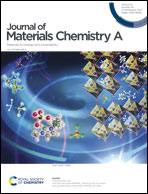3D printed, environment tolerant all-solid-state capacitive ionic skin†
Abstract
Capacitive ionic skin based on ionic conductors has undergone rapid development to improve its precision, robust structure and drift-free sensing. However, the unsatisfactory electromechanical stability of conventional capacitive ionic skins due to the instability of the components of their raw materials, which are generally vulnerable to extreme environments (−40 °C to 80 °C) remains a challenge. In addition, sensitivity is critical for ionic skins, but due to structural design defects, the sensitivity of capacitive ionic skins in extreme environments has not exceeded (2 kPa−1) and its detection range is very limited (35 Pa to 3 MPa). This study reports the development of a sensitive solid-state capacitive ionic skin (SCIS) based on polymerizable deep eutectic solvents (PDESs). The SCIS is fabricated by the photopolymerization 3D printing of two PDES monomers: acrylamide (AAm)/choline chloride (ChCl) and maleic acid (MA)/ChCl type PDESs, in which the poly(AAm/ChCl) as hard segments (guaranteed mechanical strength at high temperatures) and the poly(MA/ChCl) as soft segments (guaranteed flexibility at low temperatures) form a random copolymer network of poly(AAm/ChCl-co-MA/ChCl) after polymerization. The design of the all-in-one molecular networks allows the random copolymer to be stable over a wide temperature range (−70 °C to 120 °C) while maintaining high transparency (92%) and being compressible and conductive. Therefore, the SCIS demonstrates excellent performance in extreme environments and can be used for efficient preparation for the 3D printing of interlocked microstructures, giving the ionic skins high sensitivity (8.92 kPa−1) over a wide pressure range (50 Pa to 10 MPa). In addition, the SCIS has self-healing capabilities and response times in milliseconds in low and high temperatures. The results demonstrate the potential of the 3D printed PDES strategy to achieve highly stable and sensitive capacitive ionic skin preparations for human–machine interactions and the detection of motion signals in extreme environments.



 Please wait while we load your content...
Please wait while we load your content...